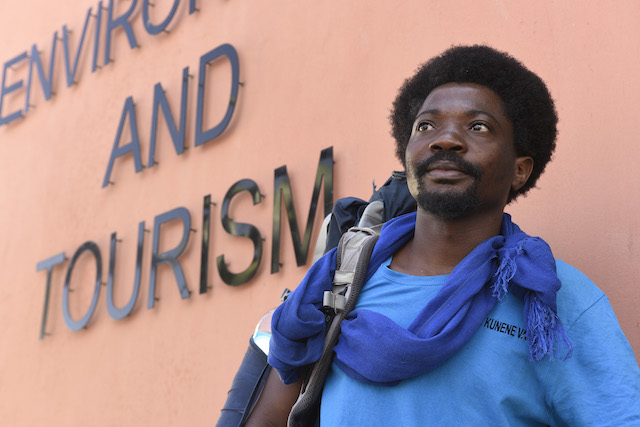WOULD YOU WALK 960 km across Namibia to make a point? It would have to be a very important point, wouldn’t it? One determined young man has just done exactly that.
Owen Kataparo Muhenje’s point certainly is not only important, it’s also urgent and selfless.
It concerns the future of one of Namibia’s most unique and spectacular natural features, and the people and biodiversity that depend on it – the Kunene River.
The severe floods experienced at the beginning of this year first motivated Owen to do the walk. Yet chatting with him it is quickly clear the issues affecting the river are many and complex.
The devastating floods that have increased in recent years are man-made, caused by the sudden release of water from dams upstream in Angola. The floods erode the riverbanks and islands, and result in significant damage to settlements along the river, including drowned livestock.
The erosion is worsened by people steadily clearing the narrow band of dense vegetation along the river to create gardens. The destruction of riverine vegetation also means the rapid loss of habitat for a myriad of small creatures. Large creatures are in trouble, too. People are increasingly poisoning crocodiles that threaten their livestock and safety.
These issues are part of a chain reaction. Years of severe drought across the north-west have devastated people’s livelihoods and have forced many to move permanently to the river. Here they can at least plant gardens and exploit the last patches of grazing for their livestock. Tourism development has also attracted many people to the river. Epupa, which in the early 1990s was hardly a village, is now a sprawling settlement.
The Kunene forms 350 km of the border between Namibia and Angola, and the issues affect both sides.
The river is a vital and unique desert lifeline for plants, animals and people. It supports diverse aquatic life, including endemic fish, otters, crocodiles and a small population of hippos.
The river valley is home to the near-endemic black-faced impala, as well as Namibia’s smallest antelope, the dik-dik. Vegetation along the river includes ancient leadwood trees, makalani palms, and huge ana and jackalberry trees.
The waterfalls at Ruacana and Epupa are truly breathtaking natural wonders and important tourism attractions. All of this is under threat.
Owen started his walk on 25 July this year. During his journey he was delayed for some time due to Covid-19 travel restrictions, and arrived in Windhoek on 6 October. The pandemic has drastically worsened an already dire situation as tourism income has evaporated.
Yet Owen feels the lack of unity in addressing issues, and the massive economic disparities between people are among the biggest problems.
He sees his discussions with people along the way as the most valuable aspect of his walk. He hopes he has raised some awareness, and says he has learnt a lot from the people he has met. The Save the Kunene initiative is of course much larger than Owen Muhenje. He is its current public face and voice. A number of large meetings have been held along the river this year to discuss the issues.
They have brought together representatives from the local communities, traditional authorities, community conservancies, tourism operators, non-government organisations and the Ministry of Mines and Energy, the Ministry of Agriculture, Water and Land Reform and the Ministry of Environment, Forestry and Tourism. All of these stakeholders can contribute to solutions. While the floods can only be solved through high-level collaboration between Namibia and Angola, most of the other issues need to be tackled by the people along the river, with support from external stakeholders.
Owen’s walk has received a lot of attention on social media.
The issues now need to receive urgent attention on the ground.
Stay informed with The Namibian – your source for credible journalism. Get in-depth reporting and opinions for
only N$85 a month. Invest in journalism, invest in democracy –
Subscribe Now!






